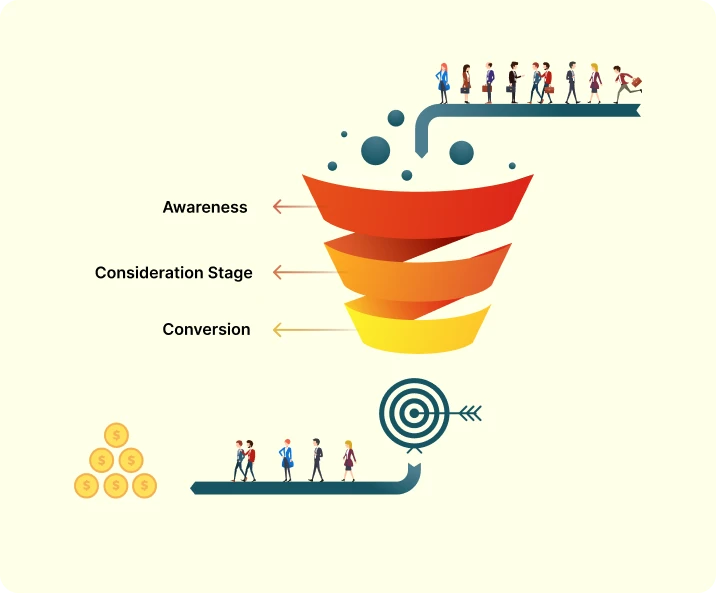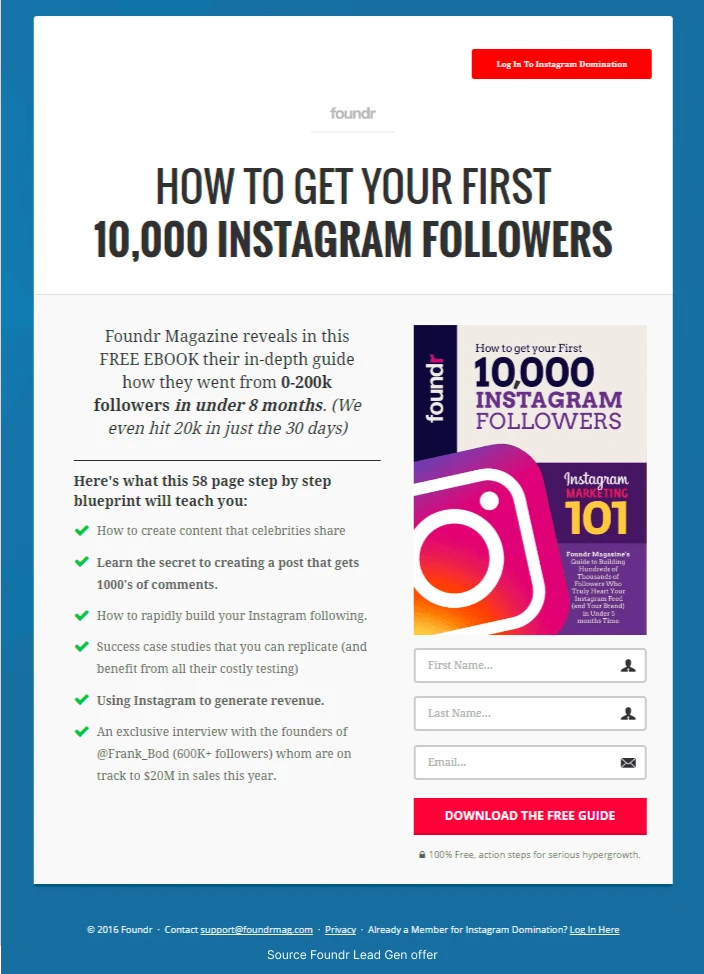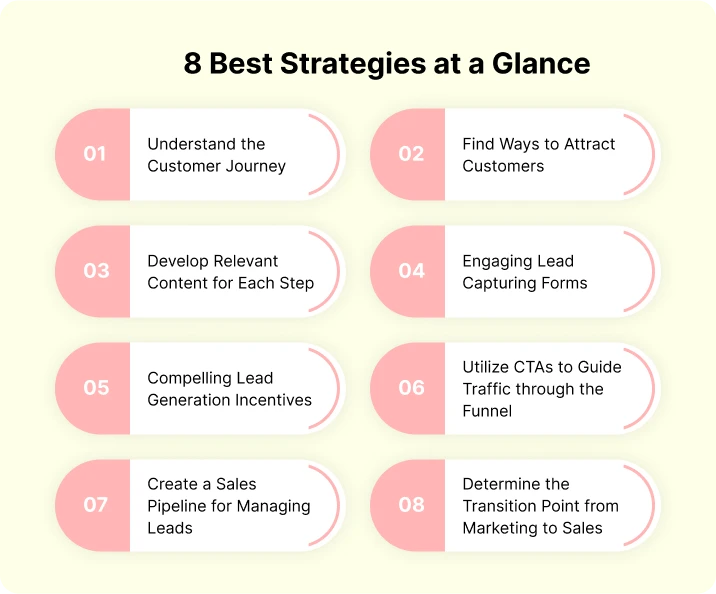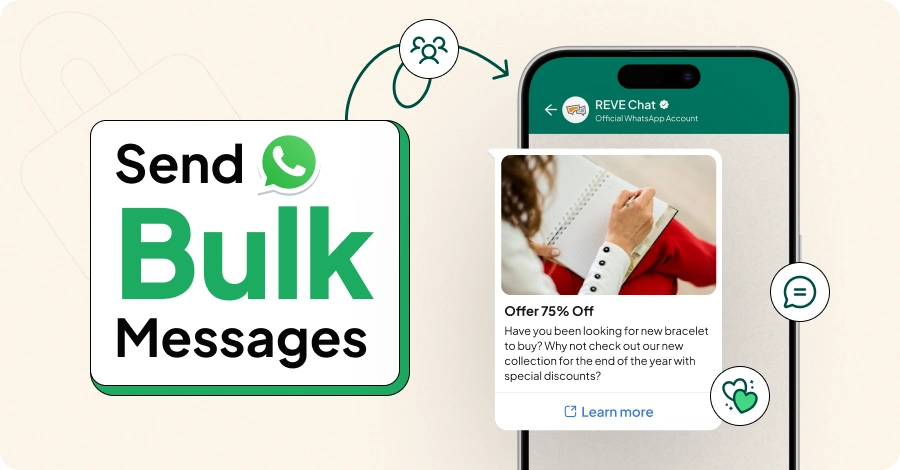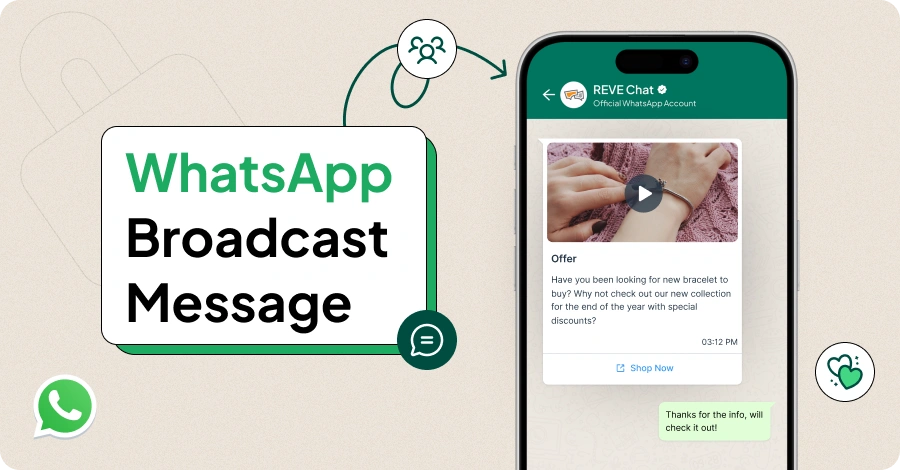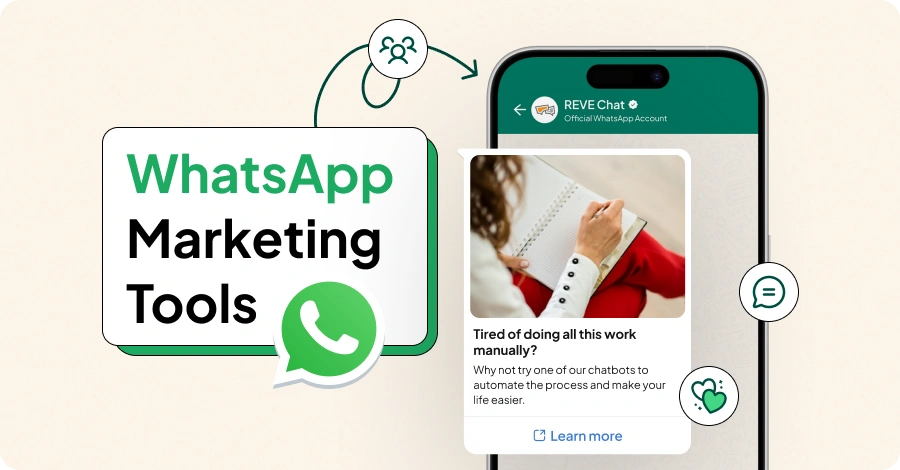What is a Lead Funnel and How to Create One
- May 20, 2024
- 19 mins read
- Listen

Table of Content
Yes, you have a business, and you need customers to run it successfully. Different marketing campaigns, social media strategies, and ads will help you boost your brand, but they don’t work to make customers buy from you. To stand strong in your business, you need a good number of sales conversions. Here, the leads funnel comes into the picture.
Without a finely tuned lead generation funnel, you will not be able to convert those secure top-tier leads. A well-structured lead funnel helps you to strategize the conversion properly. You can keep track of the total number of leads and how many of them are getting converted to make your sales process run smoothly. You also will be able to identify the root causes of leads not getting converted. In short, it serves as the guiding blueprint that navigates a prospect from being an initial contact to finally converting into an enthusiastic customer.
In this article, I will help you to understand how to do it smartly. I will cover the three stages of a lead funnel, best strategies, and practices to help you move more leads down to your funnel.
What is a Lead Funnel?
In simple terms, the lead funnel is a way through which your target audience comes to know about your product offerings, shows interest, and moves through the funnel to finally become the paying client.
The lead funnel looks like a long funnel, which is wide on top and gradually narrowed at the bottom. Leads enter through the wide part and only a portion exit as customers. Your lead funnel is the pathway you guide leads along to become paying customers, covering each stage of their journey with your business.
Building a lead funnel is crucial for any business aiming for a good return on investment (ROI). However, before you start planning and constructing a lead funnel, it’s important to understand its various stages.
How Does the Lead Funnel Work?
A lead funnel guides potential customers through a series of steps, from initially becoming aware of your product or service to eventually making a purchase.
In the lead process, both marketing and sales work together and the aim is conversion. The lead funnel helps both of these departments by organizing the whole lead process efficiently. Remember one thing! Every lead is not the same, so they never get the same treatment. All the prospects may not go through the same buyer journey.
Throughout this process, businesses use various marketing tactics and sales tools to nurture leads and move them down the funnel, ultimately converting them into customers. It’s important for you to track and analyze each stage of the funnel to optimize performance and improve conversion rates over time.
The Importance of Lead Funnel
Lead funnel suggests the best ways to get leads, build relationships, and improve your sales and marketing activities. It works like a roadmap following which your business can get a good number of quality leads with higher chances of conversions. Here are some of its benefits.
Efficiency: The lead funnel streamlines the customer acquisition process by guiding leads through sequential stages, making it easier for you to convert them into customers.
Targeting: By understanding where leads are in the funnel, you can tailor your marketing and sales efforts to address the specific needs and concerns of prospects at each stage, increasing the likelihood of conversion.
Provides Optimizable Metrics: It provides the answers for “when”, “why” and “where” behind each of your closed and failed deals so that you can pinpoint the improvement areas in your marketing and sales efforts. Optimizing those KPIs leads to better results.
Customer Insights: Analyzing the behavior of leads as they move through the sales lead funnel provides valuable insights into customer preferences, pain points, and buying behaviors, which can be used to create future marketing and sales strategies.
Scalability: A properly constructed lead generation sales funnel can expand alongside a business, enabling it to manage larger volumes of leads while maintaining efficiency and effectiveness.
The 3 Important Lead Funnel Stages
There are 3 stages of a sales funnel. Here I shall discuss each stage in detail so that you can have a thorough understanding of how each of these operates. Your marketing and sales team also have important roles to play here till conversion.
Your potential customers start at the top of the funnel (TOFU) and become leads. These leads are taken care of in the middle of the funnel (MOFU). The best leads or potential customers move to the bottom of the funnel (BOFU), where they become actual customers.
Now, let’s examine each stage more closely.
1. Top of the Funnel (Awareness)
The first stage or at the top of the funnel stays ‘Awareness.’ Here the prospects come to know that they have challenges or pain points and start looking out for solutions. Most of our easy go-to source for finding any sort of solution is Google. Research shows that more than 50% of buyers search for a new brand or product on Google.
Here, your objective is to build proper content in form of marketing materials that talk about specific customer challenges for which your product or service offers the solution and create brand awareness.
Here are a few content ideas for you!
- Blog posts
- Whitepapers
- eBooks
- Guides
- Instruction manuals
- Landing pages
- Infographics
- Newsletters
- Social media posts
- Case studies
- Customer testimonials etc.
Your prospects may not be actively seeking to buy a product or service, but they are keen to explore and gain deeper knowledge. Therefore, sales and marketing efforts targeting leads at the top of the funnel should focus on providing educational information rather than promotional ones.
Here’s one example for you. Foundr magazine offers an ebook with a great deal. If you provide your email address, they’ll show you how to gain your first 10,000 Instagram followers.
2. Middle of the Funnel (Consideration Stage)
At this stage, your prospects are already aware of your brand and the product offerings and possibly consider you as an option that they can opt for. Research shows that, on average, it requires around 84 days to progress through the consideration phase, so be ready for a lengthy process. This is when personalization and using a variety of tactics become crucial.
Now you can start finding leads. The information you have collected till now will help you figure out if the leads came from sales or marketing efforts. Marketing leads come directly from activities like social media posts, content marketing, or paid ads. Usually, they’re more likely to buy because they’ve shown interest in your business.
A sales lead might come from a landing page or sign-up form. Talking to them personally can help get them more interested in your brand. Then, you need to figure out their actual positions in the lead process. Some leads might not be ready to move forward yet as they’re not ready to buy. Others are eager to continue. By focusing on those eager leads, you have a better chance of closing deals.
Here are some tips for you:
- Provide valuable, informative content that addresses the challenges and questions your leads have at this stage.
- Create comparison guides or articles that compare your product/service with competitors. Highlight your unique selling points.
- Implement remarketing strategies to stay top-of-mind with leads who have shown interest but haven’t converted yet.
- Implement a lead scoring system to prioritize leads according to their level of engagement and their readiness to buy.
- Customize your messages to express your desire to collaborate with your prospects.
- Keep your interactions short and specific.
- Utilize a CRM or other pipeline software to track prospect engagement, clicks, and interactions.
3. Bottom of the Funnel (Conversion)
This is the last stage of the sales lead funnel. By this time, the visitors have transformed into qualified leads and are ready to purchase from you. This is the point where you can start the selling process.
You need to apply all your selling techniques including demos, free trials, customer case studies, and comparative pricing to convince them to complete the purchase.
At this stage, your objective is to reassure that the chosen leads are the right fit for your company and the product offerings. Here you need to clear out all the confusion and doubts the leads might have so that they can confidently make the buying decision.
To engage your potential customers effectively at the final stage of the sales funnel, consider these strategies:
- Demos
- Free consultations
- Free trials
- Instruction manuals
- Tutorials
- Pricing page
- Special offers and deals
- Positive customer reviews
- Sell sheets
- Comparison blog posts
B2B vs B2C Business Lead Generation Funnel
The lead generation funnel, a vital component of any sales or marketing strategy, outlines the journey from initial awareness to the final decision-making stage. While both B2B and B2C funnels aim to turn prospects into loyal customers, the methods and tactics used differ due to the distinct nature of their audiences.
B2B transactions often involve longer sales cycles, multiple decision-makers, and a focus on building professional relationships. In contrast, B2C transactions are typically more direct, driven by individual consumer needs, emotions, and a desire for immediate satisfaction.
How to Create a Lead Funnel: 8 Best Strategies
Creating an effective lead funnel is essential for capturing, nurturing, and converting potential customers. Here are eight best strategies to help you build a successful lead funnel:
1. Understand the Customer Journey
Creating a customer journey roadmap is the first step in building a lead generation funnel. This helps you understand how potential customers interact with your brand at each stage. By mapping this journey, you can identify where they lose interest and take the necessary steps to fix it. Additionally, this map shows areas where increasing customer engagement can boost customer experience, brand awareness, generate leads, and strengthen existing relationships.
Pro Tips:
- Create detailed buyer personas to represent your ideal customers. Include information on demographics, goals, challenges, and buying behaviors.
- Use surveys, interviews, and analytics to collect data on how customers interact with your brand.
- List all the points where customers interact with your brand, both online (website, social media, email, etc.) and offline (in-store, events, etc).
- Track and analyze customer behavior at each touchpoint.
- Note any stages where customers commonly experience issues or lose interest.
- Look for opportunities to enhance customer engagement at each stage.
- Regularly review and update your roadmap based on new data and changing customer behaviors.
2. Find Ways to Attract Customers
Once you have the customer journey map, find out the channels that you are going to use to be in the mind of your prospects. Prospects obviously do research about your brand before making the buying decision. For example, if they reply on review sites like G2 to understand a product in detail and get to know what others are saying about that specific one, consider improving your presence there.
Social media marketing also can be a great option for engaging with them. Running ads on social media platforms like Facebook or Instagram is also a good idea for generating leads.
Pro tips:
- Use analytic tools like Google Analytics to gather insights about your audience’s behavior, preferences, and demographics.
- Continuously run A/B tests on your content, ads, and email campaigns to determine what resonates best with your audience.
- Create high-quality informative content like blog posts, videos, podcasts, social media series, etc.
- Optimize each piece of content with relevant keywords, meta descriptions, header tags, and internal linking.
- Tailor your content and engagement strategies to fit each social media platform’s unique audience and format.
3. Develop Relevant Content for Each Step of the Lead Funnel
Crafting relevant content for each stage of the sales funnel lead generation is important for effective customer engagement and conversion. By tailoring your content to address the specific needs, preferences, and behaviors of your audience at each stage of the lead generation funnel, you can create a seamless and engaging experience. Regularly monitor and analyze the performance of your content to refine your strategy and optimize results over time.
But what is relevant content? Simply put, it should be:
- Customer-Centric: It prioritizes addressing the needs, problems, or interests of the customer.
- Dynamic: It is regularly updated to reflect changing customer interests, industry developments, or new data.
- Personalized: It is customized to the reader’s preferences, behaviors, or past interactions.
- Engaging: It is compelling, easy to navigate, and enjoyable to consume.
- Informative: It provides valuable information that helps readers make decisions.
4. Develop Engaging Lead Capturing Forms
Start using lead capture forms that help you gather important information about your prospects, engage with them, and gradually convert them into your paying customers. You need to consistently analyze performance metrics and refine strategies to ensure ongoing optimization and enhanced outcomes.
How to craft compelling lead capture forms? Here are some tips for you!
- Design visually appealing forms that are easy to navigate and pleasing to the eyes. Use colors, fonts, and images that align with your brand image and identity.
- Use concise and compelling copy to explain why prospects should fill it out and what they can expect in return.
- Keep the form fields to a minimum to decrease friction and increase completion rates.
- Ensure that the form is fully optimized for mobile devices.
- Add interactive elements such as dropdown menus, checkboxes, and sliders to make the form more engaging and interactive.
- Add social proof elements such as testimonials, ratings, or customer logos to build trust and credibility.
- Continuously test different variations of the form to identify what resonates best with your audience.
5. Craft Compelling Lead Generation Incentives
Many times, you need to entice the target audience to become leads. This can be some offers in exchange for which they will share their contact details. Many eCommerce brands often provide special discounts or free samples for collecting the contact details of their prospects. For other b2B businesses, any sort of compelling informative materials like eBooks, Video tutorials, etc. would work.
Pro tips:
- Tailor your incentives to address the specific needs, pain points, and interests of your target audience.
- Clearly communicate the benefits of your incentives.
- Design user-friendly landing pages that clearly describe your lead-generation incentives.
- Promote your incentives across various channels, including social media, email campaigns, and your website.
- Continuously test different versions of your incentives to see which ones resonate most with your audience.
- After delivering the incentive, follow up with a thank-you email and additional resources.
- Use analytics tools to track the performance of your lead-generation incentives.
6. Utilize CTAs to Guide Traffic through the Funnel
There are two types of calls to action (CTAs) to increase customer engagement: sticky CTAs and exit CTAs.
A sticky CTA is a button or banner that stays visible as users scroll through a webpage.
Exit CTAs appear when users are about to leave a website, often as pop-ups triggered by mouse movements or behavior, like moving toward the browser’s close button. People who are ready to take quick action are more likely to click the sticky CTA, while the exit CTA is for those who need a bit more time.
- Pro Tips:
- Place sticky CTAs on blog posts and informational pages. Since these CTAs are always visible, they can catch the attention of users as they explore your content.
- Use exit CTAs on landing pages to offer a special discount or a free trial when users are about to leave.
- Use simple, action-oriented language that clearly states what you want the user to do.
- Place CTAs prominently where prospects can easily see them.
- Ensure your CTAs are relevant to the content on the page.
- Provide a clear benefit to the client for clicking the CTA.
7. Create a Sales Pipeline for Managing Leads
To successfully guide sales prospects from initial contact to a closed deal, you need a structured and consistent approach. This is known as sales pipeline management.
Your sales pipeline management process will vary based on your industry, product, and sales strategy—whether you focus on outbound or inbound sales.
Here’s how to set it up effectively:
- Establish clear and regular communication with your prospects. This involves reaching out to them at the right time, providing relevant information, and being responsive to their needs and questions.
- Implement a system to determine which prospects are most likely to convert. This involves assessing their needs, budget, timeline, and fit with your product offerings.
- Be prepared to handle any questions or concerns your prospects might have.
- Go to your CRM or sales engagement platform and set up pipeline stages that reflect each step of your sales process.
- Ensure your sales pipeline is integrated with your lead generation tool. This integration helps streamline the flow of new leads into your pipeline, ensuring that no potential customer is overlooked.
8. Determine the Transition Point from Marketing to Sales
One of the most crucial elements of developing an effective lead funnel is understanding the transition point between marketing and sales. Traditionally, marketing was responsible for generating leads, which were then handed off to sales to be converted into paying customers.
However, eventually, the lines between marketing and sales have blurred. Today, these two departments often work together to engage with leads throughout every stage of the funnel. Deciding when to transition from marketing to sales is a strategic choice that depends on your specific sales process.
Regardless of when this handoff occurs, it’s essential to ensure a smooth transition. It means marketing must share all relevant data with sales, not just contact information. This includes engagement history, such as:
- Details on what content the lead has interacted with, such as blogs, eBooks, webinars, and emails.
- Insights into the lead’s behavior, including website visits, clicks, and social media engagement.
- Log of all the communications the lead has had with your company, including emails, calls, and meetings.
Best Practices for Lead Generation Sales Funnel
Optimizing your lead funnel stages involves fine-tuning each section to ensure maximum efficiency in attracting, nurturing, and converting leads. Here are some best practices to look into:
-
Use Automation
You can use automation in your customer communication at each of the stages in the lead funnel. With REVE Chatbot, automate many of your business operations including customer service. This AI customer engagement solution lets you offer instant assistance on your web, mobile, and other social media platforms like Facebook, Viber, Instagram, Telegram and WhatsApp 24/7.
-
Upsell and Cross-sell
Upselling helps you get customers to buy a more expensive version of the product they were initially interested in. Cross-selling, on the other hand, involves offering extra products that go well with the original purchase. Both of these marketing methods can boost your sales and increase profits with little extra effort.
Here’s one example from Amazon where on buying ACs, they are suggesting AC covers.
-
Optimization and Testing
Continuously test different elements of your landing pages, forms, and CTAs to identify what works best. Experiment with different headlines, images, form fields, and button colors.
-
Analytics
Use analytics tools to track the performance of your lead capture efforts. Monitor metrics such as form submission rates, bounce rates, and conversion rates to identify areas for improvement.
-
Monitor Leads’ Progress
It’s important to know their current stage, who is managing them, and the upcoming steps. Simplify this process for yourself and your team by investing in sales funnel software, which facilitates easy communication and data tracking.
-
Lead Magnets
Provide lead magnets that offer significant value, such as eBooks, whitepapers, case studies, webinars, or free trials. Ensure these offers address a pain point or need of your target audience. Use a thank-you page to deliver the content and provide further engagement opportunities.
-
Develop Attractive Landing Pages
Create clean, visually appealing landing pages with a clear focus. Avoid clutter and ensure the purpose of the page is immediately evident. Clearly state what the visitor will gain from providing their information. Use bullet points to list benefits and highlight key points. Use attention-grabbing headlines that clearly convey the value of your offer.
-
Let Leads Go If Required
Not every lead will make it through the funnel, and that’s okay. It’s not possible to convert every lead, so don’t stress if some drop off. Focus on keeping the promising ones at the forefront.
-
Add Social Proof
People trust what their friends and family say more than what a company says. So, it’s important to show what others think about your business. This could be through testimonials, reviews, or stories from your existing customers. Put these where people can see them easily as they decide whether to buy your product. For example, show reviews on your product page and happy customer stories on your checkout page. This helps people feel more confident when they’re about to buy something.
-
Follow Up
Set up drip campaigns to automatically reach out to leads. Send a series of emails that provide helpful content related to their interests and preferences. Keep your brand in their thoughts as they progress through the lead funnel. Additionally, these follow-ups can assist leads who are astuck or who have abandoned their shopping carts.
Offer Personalized Support at Every Stage of Your Lead Funnel with REVE Chat
Your leads are crucial in your lead funnel journey, and they are bound to need some guidance along the way! One of the most effective ways to turn them into paying customers is by providing personalized assistance at each step, in real-time. That’s where REVE Chat comes in to save the day. It’s an AI-powered omnichannel customer support platform that offers instant assistance across your website, mobile app, and various social media platforms.
With REVE Chat, you get live chat, chatbot, and ticketing system all bundled together in one convenient platform, ensuring you can manage your customer service seamlessly. Plus, you can monitor visitors in real-time and proactively reach out to them to offer assistance even before they ask for it.
Excited to give it a try? SIGN UP for its 14-day free trial today and experience the difference firsthand!

